flat tire TOYOTA C-HR 2020 Warranties & Maintenance Guides (in English)
[x] Cancel search | Manufacturer: TOYOTA, Model Year: 2020, Model line: C-HR, Model: TOYOTA C-HR 2020Pages: 260, PDF Size: 8.54 MB
Page 202 of 260
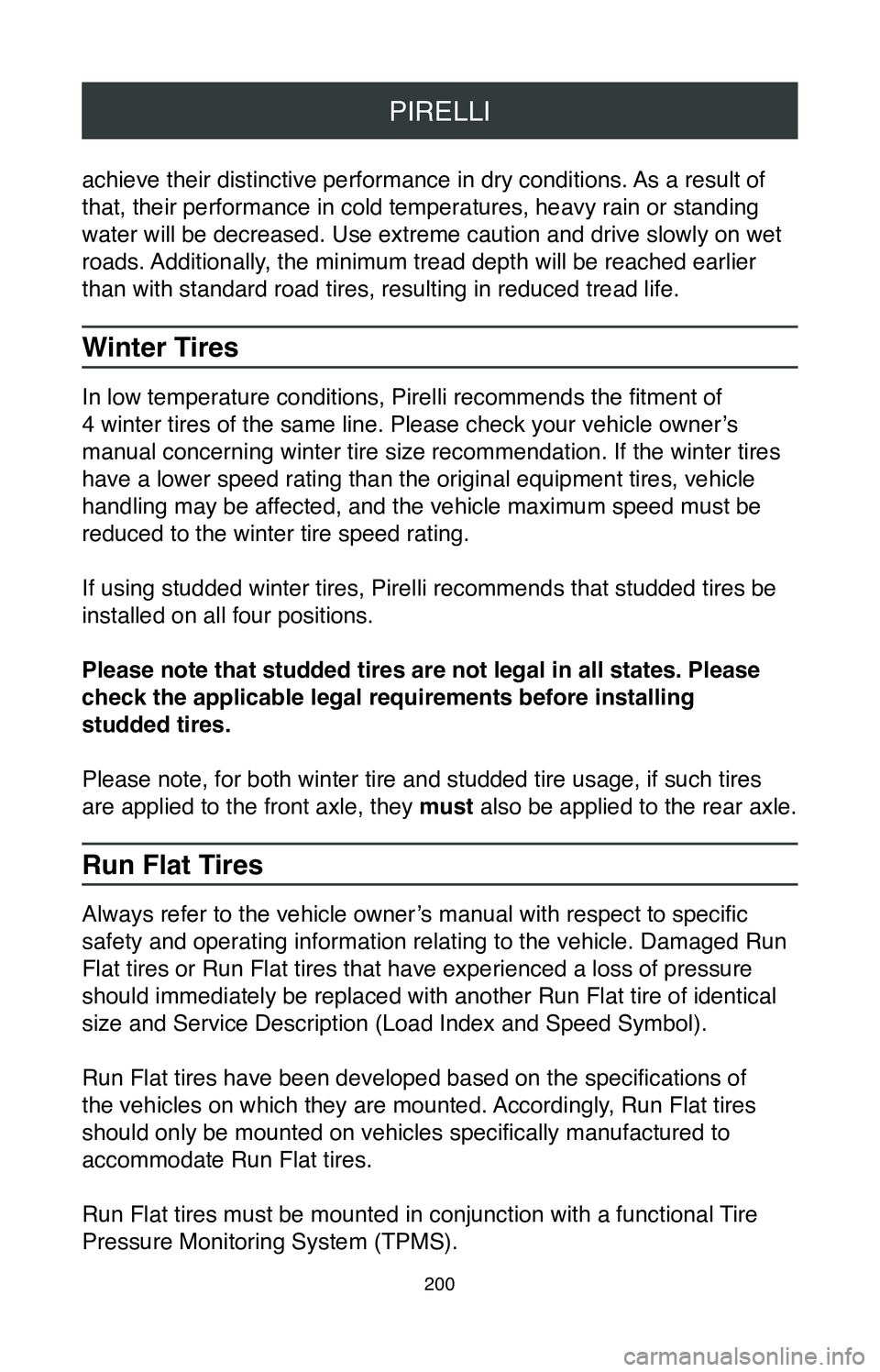
PIRELLI
200
achieve their distinctive performance in dry conditions. As a result of
that, their performance in cold temperatures, heavy rain or standing
water will be decreased. Use extreme caution and drive slowly on wet
roads. Additionally, the minimum tread depth will be reached earlier
than with standard road tires, resulting in reduced tread life.
Winter Tires
In low temperature conditions, Pirelli recommends the fitment of
4 winter tires of the same line. Please check your vehicle owner’s
manual concerning winter tire size recommendation. If the winter tires
have a lower speed rating than the original equipment tires, vehicle
handling may be affected, and the vehicle maximum speed must be
reduced to the winter tire speed rating.
If using studded winter tires, Pirelli recommends that studded tires be \
installed on all four positions.
Please note that studded tires are not legal in all states. Please
check the applicable legal requirements before installing
studded tires.
Please note, for both winter tire and studded tire usage, if such tires \
are applied to the front axle, they must also be applied to the rear axle.
Run Flat Tires
Always refer to the vehicle owner’s manual with respect to specific
safety and operating information relating to the vehicle. Damaged Run
Flat tires or Run Flat tires that have experienced a loss of pressure
should immediately be replaced with another Run Flat tire of identical
size and Service Description (Load Index and Speed Symbol).
Run Flat tires have been developed based on the specifications of
the vehicles on which they are mounted. Accordingly, Run Flat tires
should only be mounted on vehicles specifically manufactured to
accommodate Run Flat tires.
Run Flat tires must be mounted in conjunction with a functional Tire
Pressure Monitoring System (TPMS).
Page 204 of 260
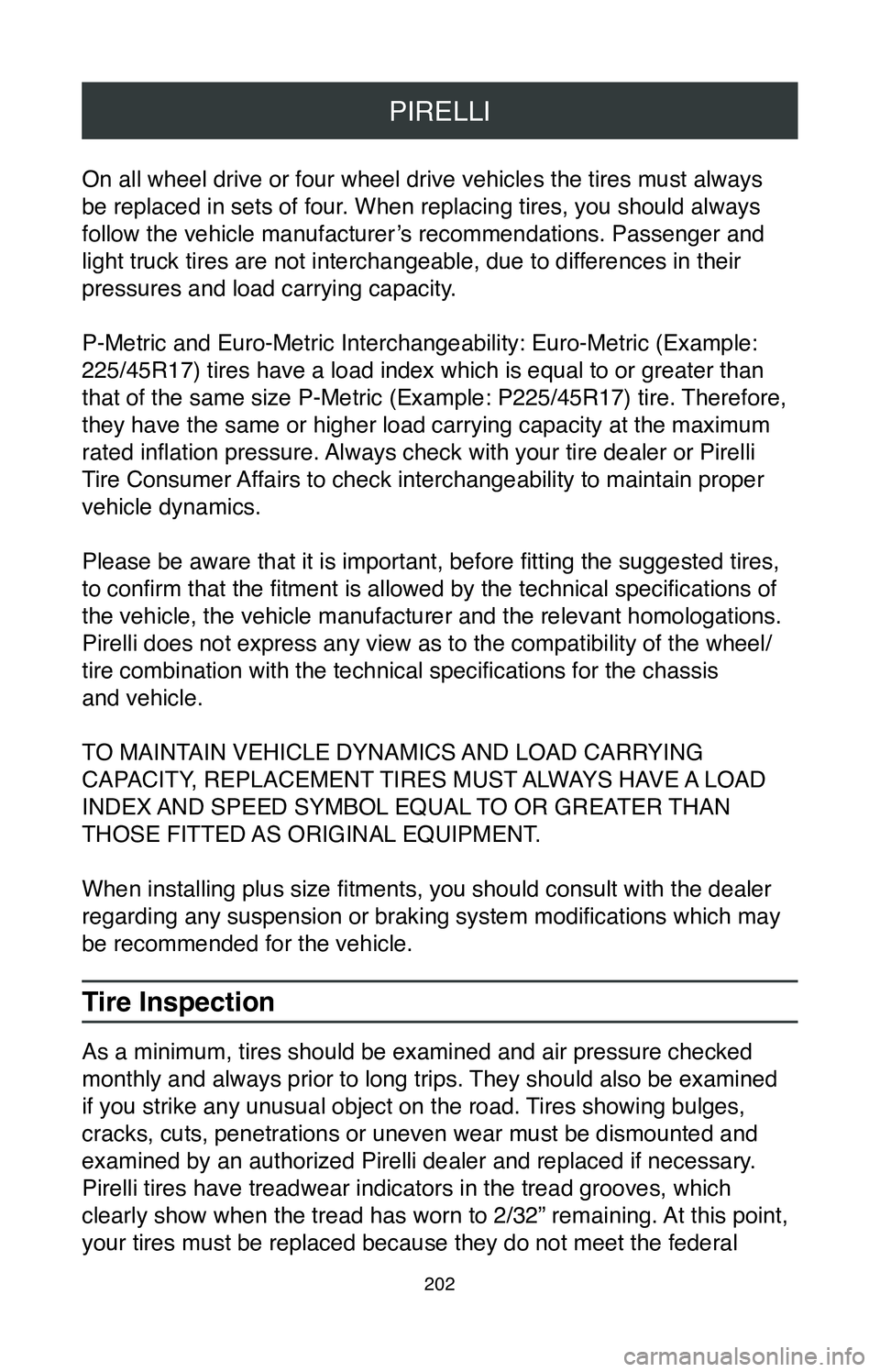
PIRELLI
202
On all wheel drive or four wheel drive vehicles the tires must always
be replaced in sets of four. When replacing tires, you should always
follow the vehicle manufacturer’s recommendations. Passenger and
light truck tires are not interchangeable, due to differences in their
pressures and load carrying capacity.
P-Metric and Euro-Metric Interchangeability: Euro-Metric (Example:
225/45R17) tires have a load index which is equal to or greater than
that of the same size P-Metric (Example: P225/45R17) tire. Therefore,
they have the same or higher load carrying capacity at the maximum
rated inflation pressure. Always check with your tire dealer or Pirelli
Tire Consumer Affairs to check interchangeability to maintain proper
vehicle dynamics.
Please be aware that it is important, before fitting the suggested tires,
to confirm that the fitment is allowed by the technical specifications of
the vehicle, the vehicle manufacturer and the relevant homologations.
Pirelli does not express any view as to the compatibility of the wheel/
tire combination with the technical specifications for the chassis
and vehicle.
TO MAINTAIN VEHICLE DYNAMICS AND LOAD CARRYING
CAPACITY, REPLACEMENT TIRES MUST ALWAYS HAVE A LOAD
INDEX AND SPEED SYMBOL EQUAL TO OR GREATER THAN
THOSE FITTED AS ORIGINAL EQUIPMENT.
When installing plus size fitments, you should consult with the dealer
regarding any suspension or braking system modifications which may
be recommended for the vehicle.
Tire Inspection
As a minimum, tires should be examined and air pressure checked
monthly and always prior to long trips. They should also be examined
if you strike any unusual object on the road. Tires showing bulges,
cracks, cuts, penetrations or uneven wear must be dismounted and
examined by an authorized Pirelli dealer and replaced if necessary.
Pirelli tires have treadwear indicators in the tread grooves, which
clearly show when the tread has worn to 2/32” remaining. At this point,
your tires must be replaced because they do not meet the federal
Page 205 of 260
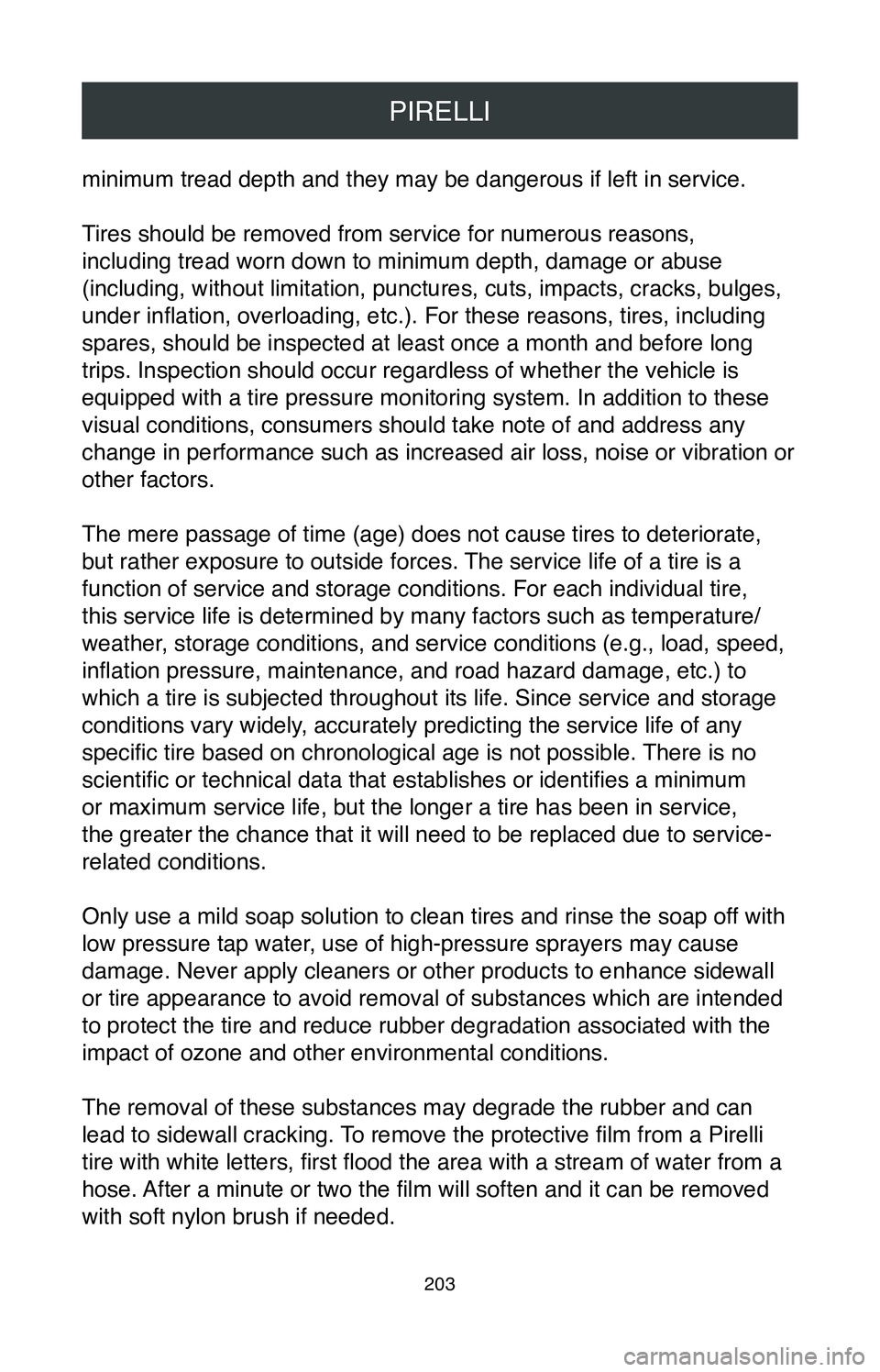
PIRELLI
203
minimum tread depth and they may be dangerous if left in service.
Tires should be removed from service for numerous reasons,
including tread worn down to minimum depth, damage or abuse
(including, without limitation, punctures, cuts, impacts, cracks, bulges,
under inflation, overloading, etc.). For these reasons, tires, including
spares, should be inspected at least once a month and before long
trips. Inspection should occur regardless of whether the vehicle is
equipped with a tire pressure monitoring system. In addition to these
visual conditions, consumers should take note of and address any
change in performance such as increased air loss, noise or vibration or \
other factors.
The mere passage of time (age) does not cause tires to deteriorate,
but rather exposure to outside forces. The service life of a tire is a
function of service and storage conditions. For each individual tire,
this service life is determined by many factors such as temperature/
weather, storage conditions, and service conditions (e.g., load, speed,
inflation pressure, maintenance, and road hazard damage, etc.) to
which a tire is subjected throughout its life. Since service and storage
conditions vary widely, accurately predicting the service life of any
specific tire based on chronological age is not possible. There is no
scientific or technical data that establishes or identifies a minimum
or maximum service life, but the longer a tire has been in service,
the greater the chance that it will need to be replaced due to service-
related conditions.
Only use a mild soap solution to clean tires and rinse the soap off with
low pressure tap water, use of high-pressure sprayers may cause
damage. Never apply cleaners or other products to enhance sidewall
or tire appearance to avoid removal of substances which are intended
to protect the tire and reduce rubber degradation associated with the
impact of ozone and other environmental conditions.
The removal of these substances may degrade the rubber and can
lead to sidewall cracking. To remove the protective film from a Pirelli
tire with white letters, first flood the area with a stream of water from a
hose. After a minute or two the film will soften and it can be removed
with soft nylon brush if needed.
Page 210 of 260
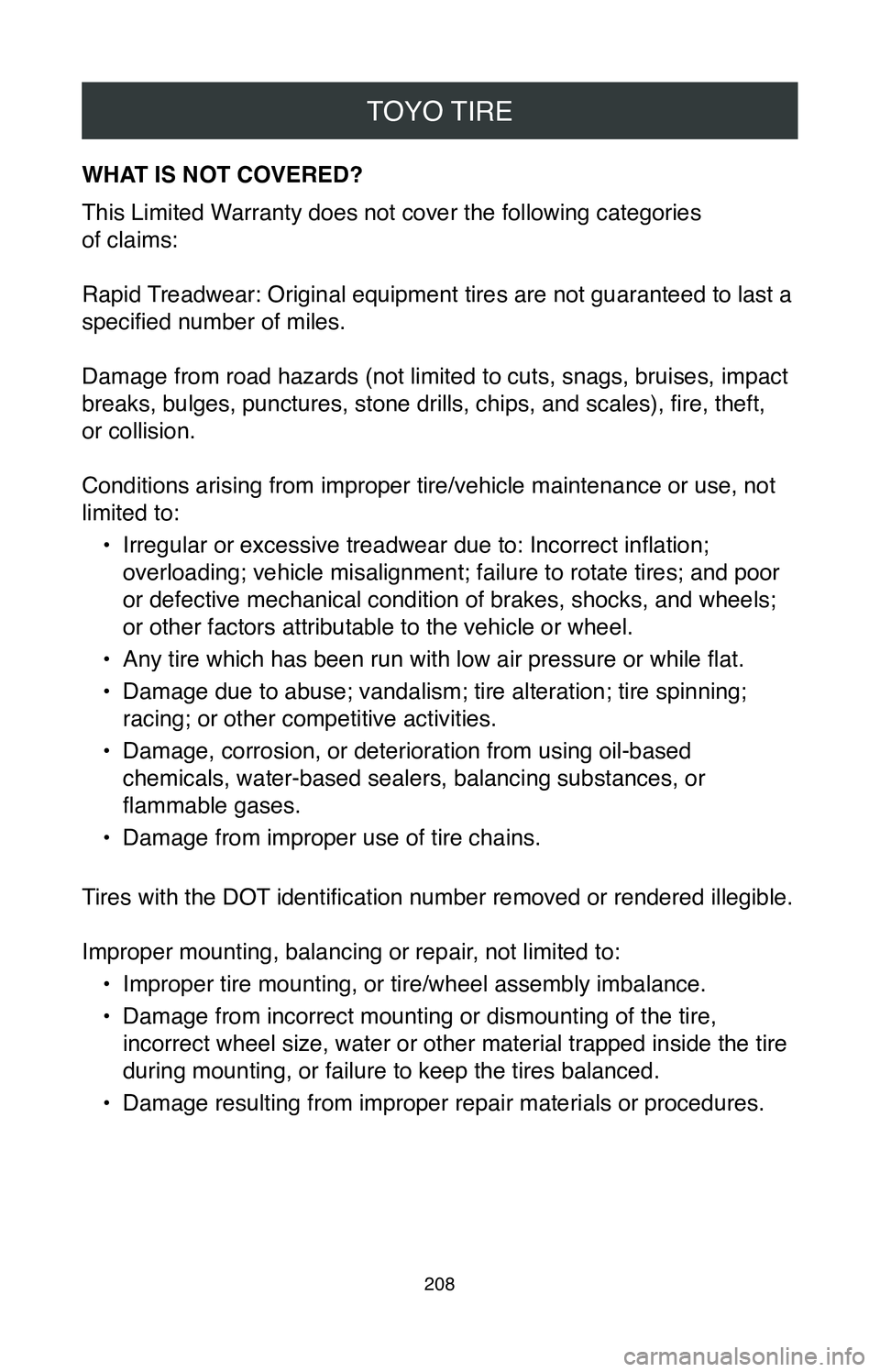
TOYO TIRE
208
WHAT IS NOT COVERED?
This Limited Warranty does not cover the following categories
of claims:
Rapid Treadwear: Original equipment tires are not guaranteed to last a
specified number of miles.
Damage from road hazards (not limited to cuts, snags, bruises, impact
breaks, bulges, punctures, stone drills, chips, and scales), fire, theft,
or collision.
Conditions arising from improper tire/vehicle maintenance or use, not
limited to:
•
Irregular or excessive treadwear due to: Incorrect inflation;
overloading; vehicle misalignment; failure to rotate tires; and poor
or defective mechanical condition of brakes, shocks, and wheels;
or other factors attributable to the vehicle or wheel.
•
Any tire which has been run with low air pressure or while flat.
•
Damage due to abuse; vandalism; tire alteration; tire spinning;
racing; or other competitive activities.
•
Damage, corrosion, or deterioration from using oil-based
chemicals, water-based sealers, balancing substances, or
flammable gases.
•
Damage from improper use of tire chains.
Tires with the DOT identification number removed or rendered illegible.
Improper mounting, balancing or repair, not limited to: •
Improper tire mounting, or tire/wheel assembly imbalance.
•
Damage from incorrect mounting or dismounting of the tire,
incorrect wheel size, water or other material trapped inside the tire
during mounting, or failure to keep the tires balanced.
•
Damage resulting from improper repair materials or procedures.
Page 215 of 260
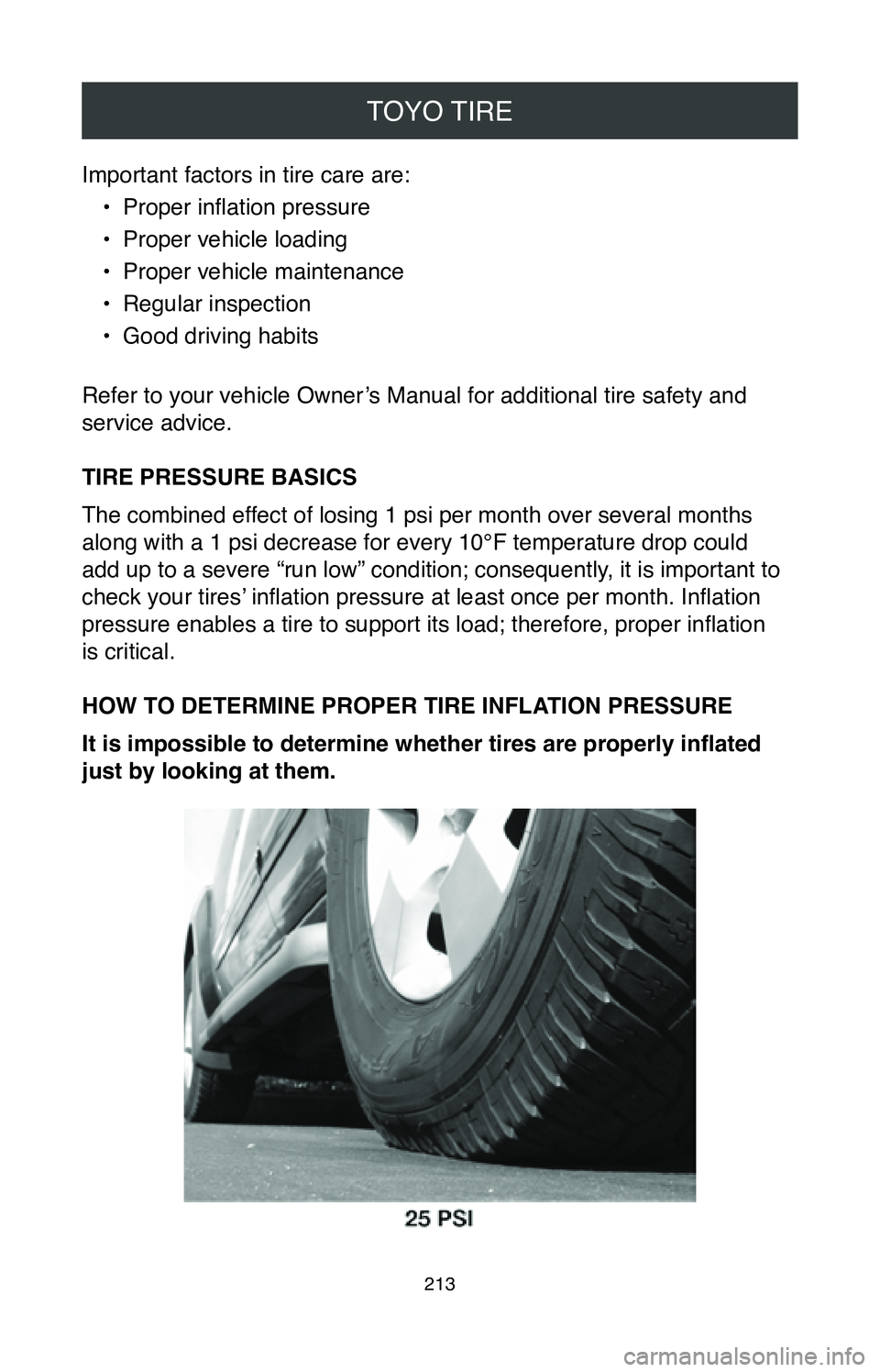
TOYO TIRE
213
Important factors in tire care are:•
Proper inflation pressure
•
Proper vehicle loading
•
Proper vehicle maintenance
•
Regular inspection
•
Good driving habits
Refer to your vehicle Owner’s Manual for additional tire safety and
service advice.
TIRE PRESSURE BASICS
The combined effect of losing 1 psi per month over several months
along with a 1 psi decrease for every 10°F temperature drop could
add up to a severe “run low” condition; consequently, it is important to
check your tires’ inflation pressure at least once per month. Inflation
pressure enables a tire to support its load; therefore, proper inflation
is critical.
HOW TO DETERMINE PROPER TIRE INFLATION PRESSURE
It is impossible to determine whether tires are properly inflated
just by looking at them.
Page 217 of 260
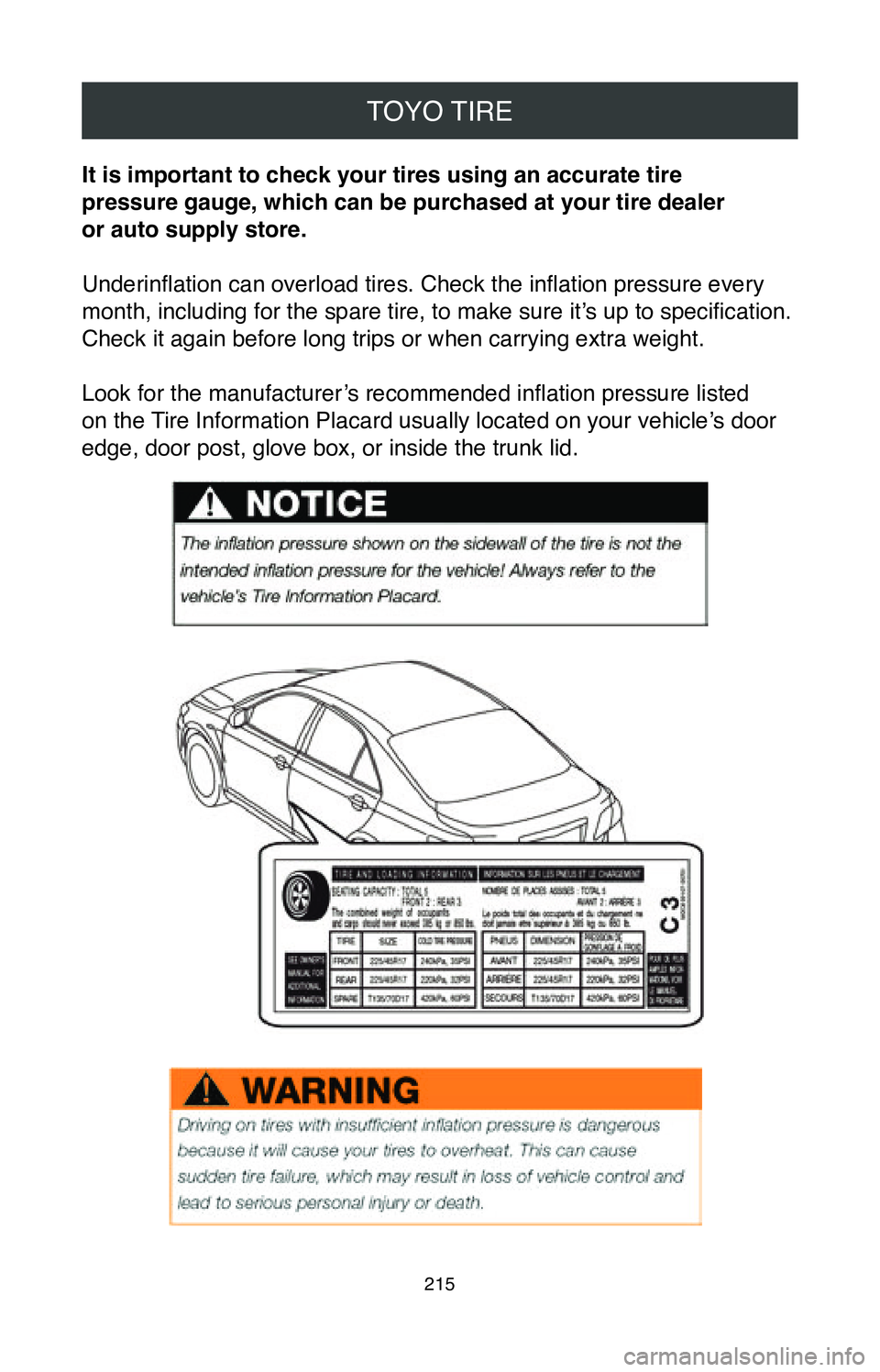
TOYO TIRE
215
It is important to check your tires using an accurate tire
pressure gauge, which can be purchased at your tire dealer
or auto supply store.
Underinflation can overload tires. Check the inflation pressure every
month, including for the spare tire, to make sure it’s up to specification.
Check it again before long trips or when carrying extra weight.
Look for the manufacturer’s recommended inflation pressure listed
on the Tire Information Placard usually located on your vehicle’s door
edge, door post, glove box, or inside the trunk lid.
Page 218 of 260
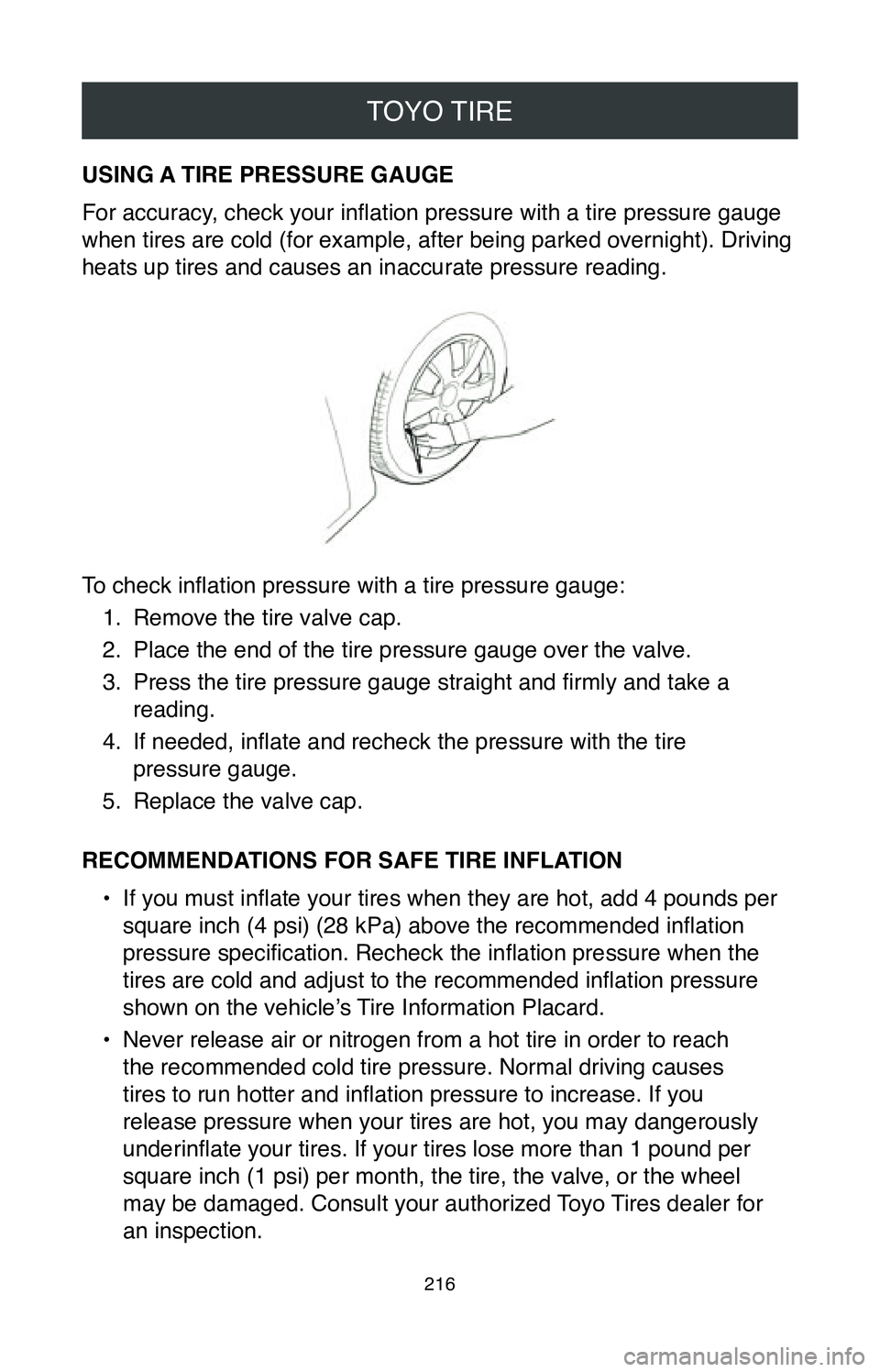
TOYO TIRE
216
USING A TIRE PRESSURE GAUGE
For accuracy, check your inflation pressure with a tire pressure gauge
when tires are cold (for example, after being parked overnight). Driving
heats up tires and causes an inaccurate pressure reading.
To check inflation pressure with a tire pressure gauge:1.
Remove the tire valve cap.
2.
Place the end of the tire pressure gauge over the valve.
3.
Press the tire pressure gauge straight and firmly and take a
reading.
4.
If needed, inflate and recheck the pressure with the tire
pressure gauge.
5.
Replace the valve cap.
RECOMMENDATIONS FOR SAFE TIRE INFLATION •
If you must inflate your tires when they are hot, add 4 pounds per
square inch (4 psi) (28 kPa) above the recommended inflation
pressure specification. Recheck the inflation pressure when the
tires are cold and adjust to the recommended inflation pressure
shown on the vehicle’s Tire Information Placard.
•
Never release air or nitrogen from a hot tire in order to reach
the recommended cold tire pressure. Normal driving causes
tires to run hotter and inflation pressure to increase. If you
release pressure when your tires are hot, you may dangerously
underinflate your tires. If your tires lose more than 1 pound per
square inch (1 psi) per month, the tire, the valve, or the wheel
may be damaged. Consult your authorized Toyo Tires dealer for
an inspection.
Page 219 of 260
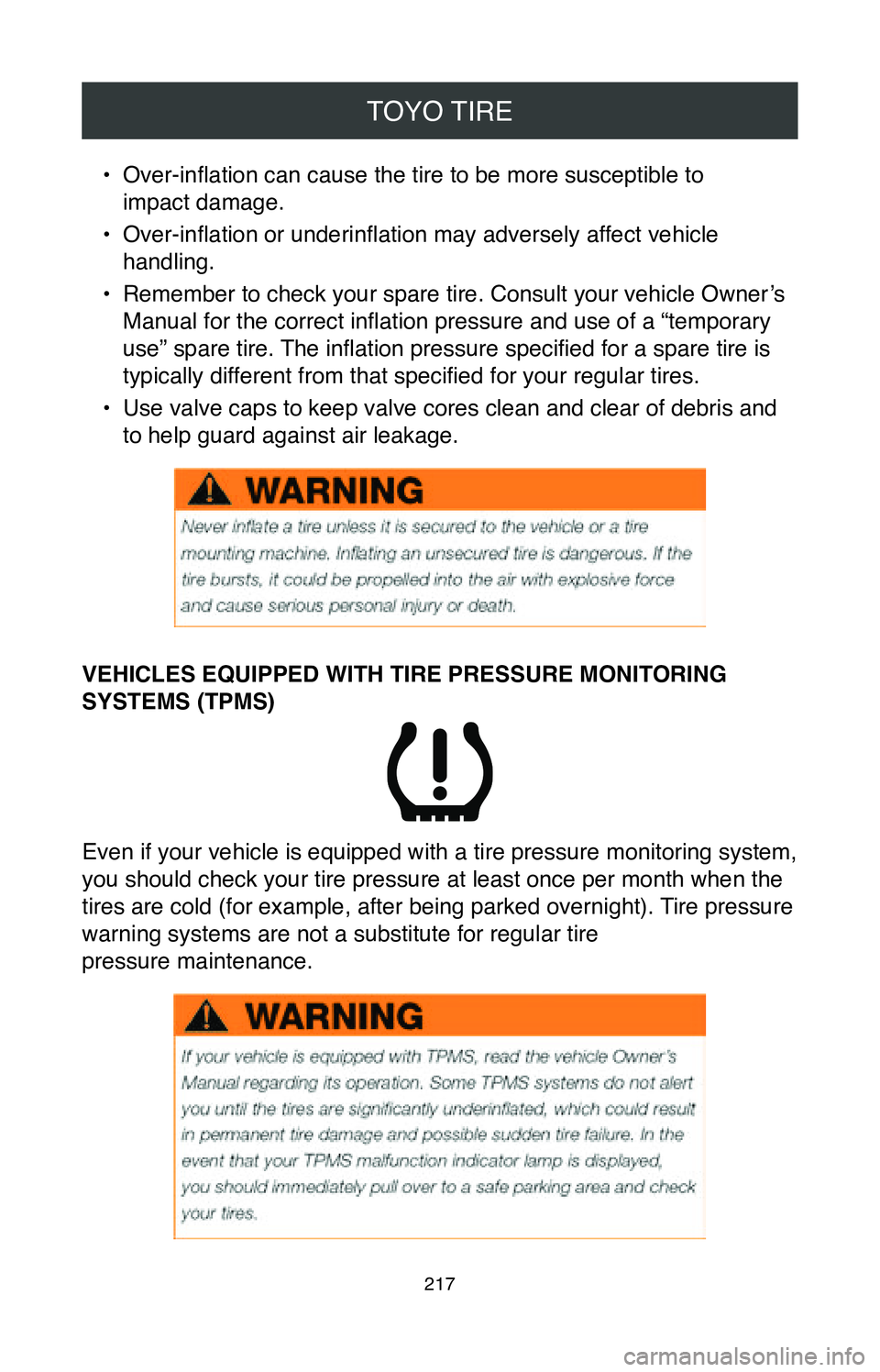
TOYO TIRE
217
• Over-inflation can cause the tire to be more susceptible to
impact damage.
•
Over-inflation or underinflation may adversely affect vehicle
handling.
•
Remember to check your spare tire. Consult your vehicle Owner’s
Manual for the correct inflation pressure and use of a “temporary
use” spare tire. The inflation pressure specified for a spare tire is
typically different from that specified for your regular tires.
•
Use valve caps to keep valve cores clean and clear of debris and
to help guard against air leakage.
VEHICLES EQUIPPED WITH TIRE PRESSURE MONITORING
SYSTEMS (TPMS)
Even if your vehicle is equipped with a tire pressure monitoring system,\
you should check your tire pressure at least once per month when the
tires are cold (for example, after being parked overnight). Tire pressure
warning systems are not a substitute for regular tire
pressure maintenance.
Page 220 of 260
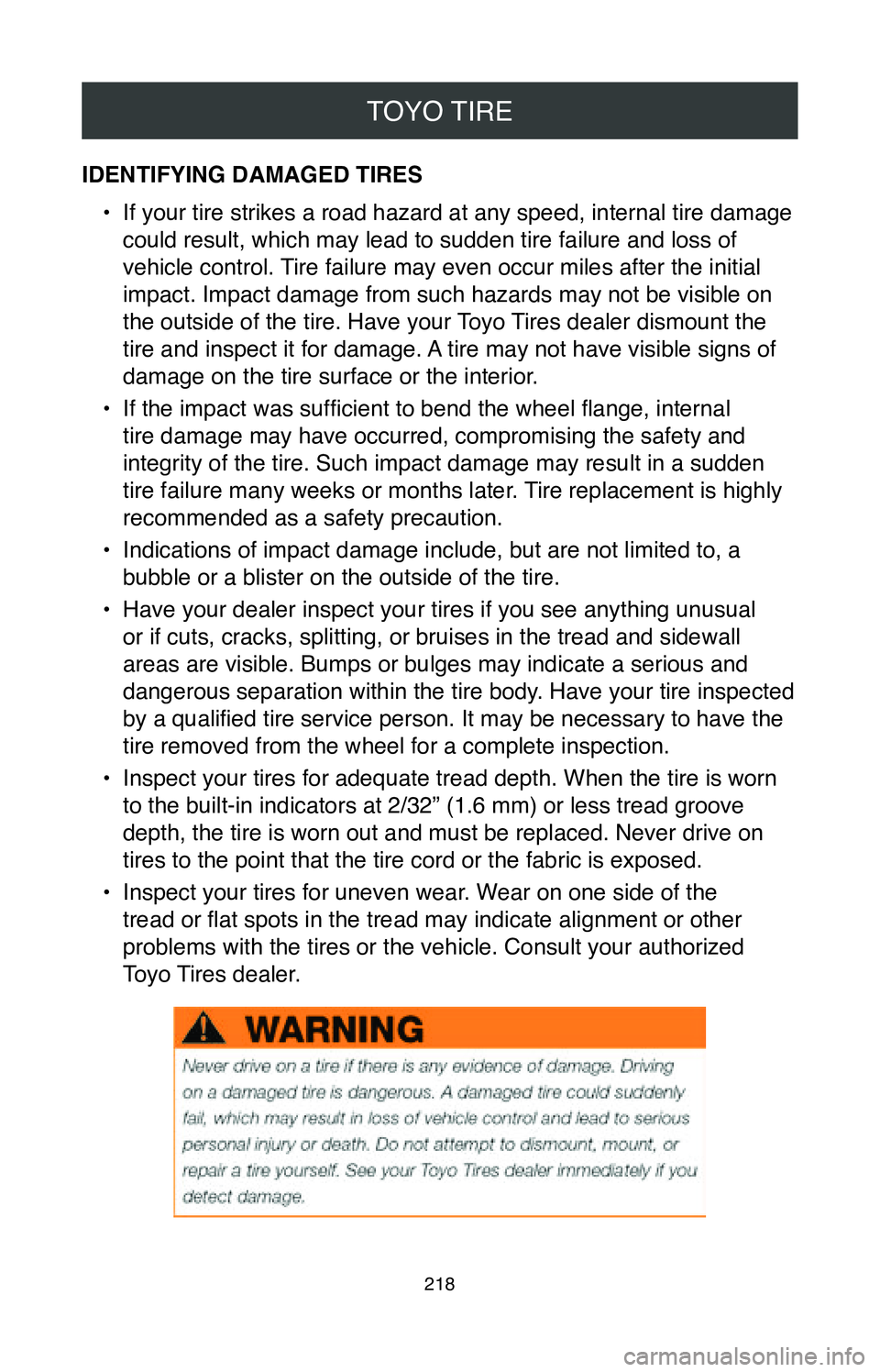
TOYO TIRE
218
IDENTIFYING DAMAGED TIRES•
If your tire strikes a road hazard at any speed, internal tire damage
could result, which may lead to sudden tire failure and loss of
vehicle control. Tire failure may even occur miles after the initial
impact. Impact damage from such hazards may not be visible on
the outside of the tire. Have your Toyo Tires dealer dismount the
tire and inspect it for damage. A tire may not have visible signs of
damage on the tire surface or the interior.
•
If the impact was sufficient to bend the wheel flange, internal
tire damage may have occurred, compromising the safety and
integrity of the tire. Such impact damage may result in a sudden
tire failure many weeks or months later. Tire replacement is highly
recommended as a safety precaution.
•
Indications of impact damage include, but are not limited to, a
bubble or a blister on the outside of the tire.
•
Have your dealer inspect your tires if you see anything unusual
or if cuts, cracks, splitting, or bruises in the tread and sidewall
areas are visible. Bumps or bulges may indicate a serious and
dangerous separation within the tire body. Have your tire inspected
by a qualified tire service person. It may be necessary to have the
tire removed from the wheel for a complete inspection.
•
Inspect your tires for adequate tread depth. When the tire is worn
to the built-in indicators at 2/32” (1.6 mm) or less tread groove
depth, the tire is worn out and must be replaced. Never drive on
tires to the point that the tire cord or the fabric is exposed.
•
Inspect your tires for uneven wear. Wear on one side of the
tread or flat spots in the tread may indicate alignment or other
problems with the tires or the vehicle. Consult your authorized
Toyo Tires dealer.
Page 224 of 260
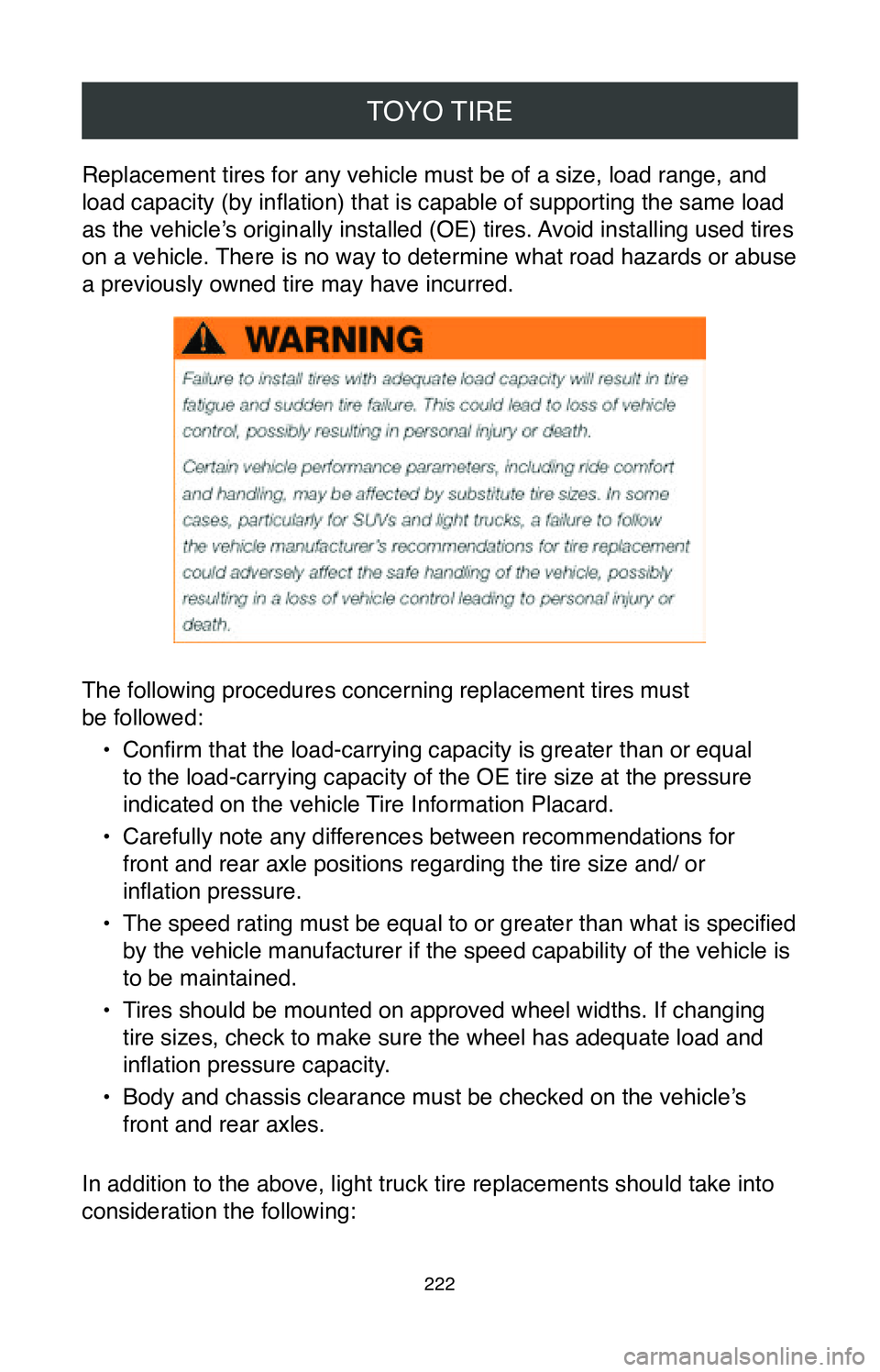
TOYO TIRE
222
Replacement tires for any vehicle must be of a size, load range, and
load capacity (by inflation) that is capable of supporting the same load
as the vehicle’s originally installed (OE) tires. Avoid installing used tires
on a vehicle. There is no way to determine what road hazards or abuse
a previously owned tire may have incurred.
The following procedures concerning replacement tires must
be followed:•
Confirm that the load-carrying capacity is greater than or equal
to the load-carrying capacity of the OE tire size at the pressure
indicated on the vehicle Tire Information Placard.
•
Carefully note any differences between recommendations for
front and rear axle positions regarding the tire size and/ or
inflation pressure.
•
The speed rating must be equal to or greater than what is specified
by the vehicle manufacturer if the speed capability of the vehicle is
to be maintained.
•
Tires should be mounted on approved wheel widths. If changing
tire sizes, check to make sure the wheel has adequate load and
inflation pressure capacity.
•
Body and chassis clearance must be checked on the vehicle’s
front and rear axles.
In addition to the above, light truck tire replacements should take into\
consideration the following: